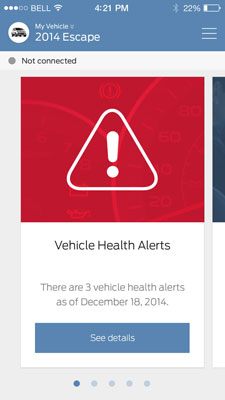Writing content for the Ford Owner mobile app remains one of my all-time favorite projects from my days at Razorfish. I worked with an incredibly smart team, took my writing into new directions, and expanded my skill set into the big, bad, fascinating world of content strategy.
It also introduced me to artificial intelligence. Working on the project felt like teetering around on a fabulous pair of sky-high platform shoes and getting a peek into how AI is making its way from the Twilight Zone into our daily lives. Here’s how it all went down.
Razorfish maintained the Ford Owner site, which is where Ford customers go to get help, updates, and information about their vehicle. I was originally hired to write articles to support the launch of SYNC 3, Ford’s in-vehicle entertainment system. SYNC 3 is much more than a glorified radio. The system connects a mobile device to the vehicle so people can play music, get directions, talk on the phone, receive text messages, and perform other slightly-dangerous tasks that probably shouldn’t be done from behind the wheel.

A vehicle health alert – change that oil!
As we got closer to the deadline a parallel project was heating up—Razorfish needed to update the Ford Owner mobile app to include content and select functionality available through SYNC 3. The project required content support, and my incredibly generous manager asked me if I wanted to be the content lead since I was familiar with the content from the launch. I said yes, and we were off.
Before I could write anything, I had to learn how the app worked. I spent as much time as I could with my UX and BA teammates to understand how the copy would flow from screen to screen. I spent even more time pouring over functional specifications to figure out how to surface key technical information and translate it to a mobile audience. And I had more fun than I care to admit “driving” the fake car we had in the office so I could test out the app’s features.
Setting the tone
The app was an extension of the Ford Owner site, and its main purpose was to give owners fast access to information about their vehicle. On the whole Ford’s customers aren’t a technical crowd, so anything I wrote had to be crystal clear. Since the app essentially gave people instructions on how to use new features of SYNC 3, the tone of all the content had to be very direct, almost like giving orders but in a helpful, not militaristic, way.
We didn’t need a ton of copy for the app, but I had to adhere to some strict character count guidelines. Writing for a mobile screen was like downsizing from a mansion to a tiny house, there was no space for anything that didn’t belong. I also felt like I was writing some kind of technical poem; it was a constant balance between form and function.

The tutorial that made us all nuts.
Writing about the app’s new features was challenging. These features enabled drivers to lock and unlock their car, keep track of parking meters, and get information or receive scary alerts about their vehicle’s health. While the new features seemed simple on the surface, the functionality under the hood was complex. It was tricky to surface the right amount of information that would give users the information they needed to get things working without having to call the help desk. Writing a tutorial was especially tricky—the entire team had to figure out how to fit all the steps, as well as Ford’s branding, on one screen. Features were added and removed along the way, and the app launched on time, just before Christmas of 2015.
During the project the team had tons of conversations about driverless cars, AI, and where it all might lead (the one about the ethics of programming an accident still leaves me queasy). SYNC is essentially the artificial brain that powers tons of automated activities that would blow Henry Ford’s mind. It was fascinating to talk to the engineers just outside of Detroit about the far-out ideas they wanted to bring into dashboards, and hear how our dev team could figure out a way to do it. A lot of those ideas are still a few years away from reality, but we’re getting closer, and I’m glad I had a sneak preview of how it all may come together.